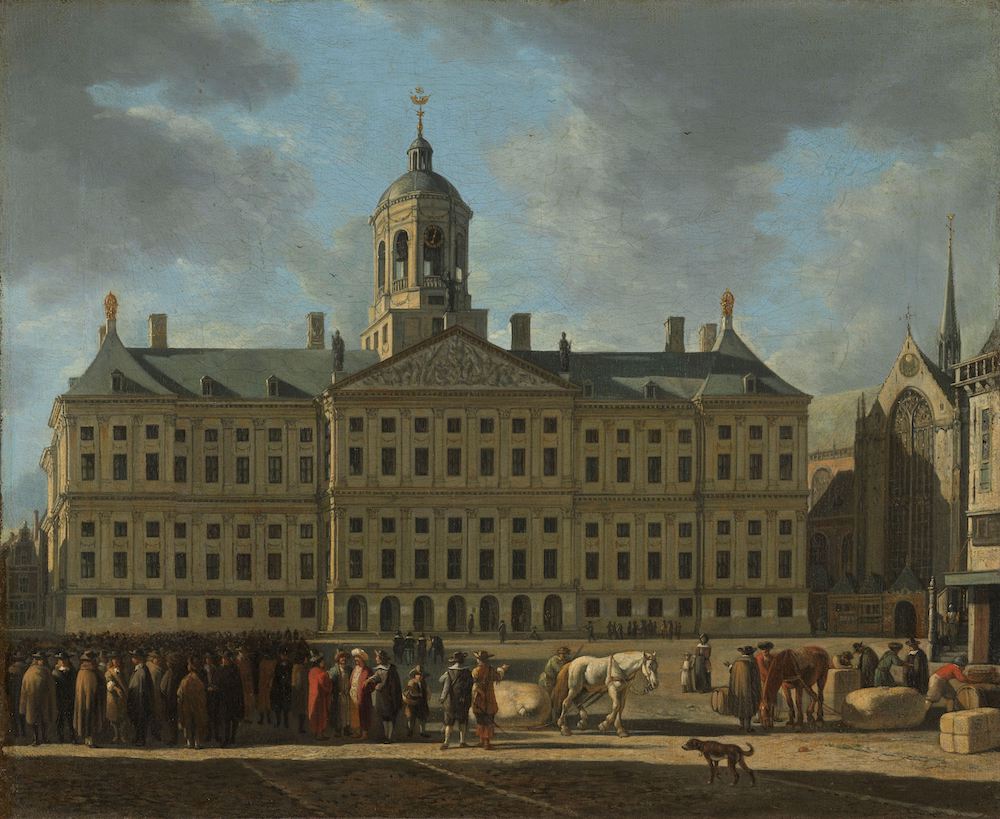The VOC and Amsterdam’s first exchange building
This image shows the exchange building of Amsterdam in the early-modern era, known as the Hendrick de Keyser Exchange, after the building’s architect. It no longer exists. After two centuries of subsidence problems, the city decided to tear it down in the 19th century. It used to stand just south of Dam Square, where it was built over the watercourse of the Amstel River—small vessels could pass underneath. This had probably been too ambitious for the early 17th-century builders and caused the subsidence problems.

Collection of the Capital Amsterdam foundation.
From August 1611, when the exchange building opened, this was the place where most share transactions were negotiated. But it was not a stock exchange as we know stock exchanges from, especially, the 20th century, where only stocks, bonds and other financial instruments were traded. This was first of all a commodities exchange, where merchants in beer, salt, grain, timber and many other goods came to do their business. Right at the back was the place where shares were bought and sold.
Trading in all weathers
The Hendrick de Keyser Exchange had a large open courtyard, just like the exchange buildings of Antwerp, London and Rotterdam, which all predated the Amsterdam exchange. But the share traders were used to something. Before the exchange building was finished, trade took place on ‘Nieuwe Brug’ (New Bridge), the northernmost bridge over Damrak, by the harbor. Nowadays, this is right opposite Amsterdam’s Central Station, which stands on an island that was not constructed until the 19th century.

Stadsarchief Amsterdam. License: CC0.
Amsterdam’s city council had designated this bridge as the city’s trade location in 1561. Before that, the commodities merchants had gathered in Warmoesstraat, where many of the major merchants of that time lived. They had only to step out of their houses to meet other merchants and do business, and this in turn drew businessmen from other parts of the city. As Amsterdam became more important as a center of commerce and more and more merchants settled there, the trading between dealers on the street became a problem. At this time Warmoesstraat was still an important transport artery, and the merchants blocked the way.

Stadsarchief Amsterdam. License: CC0.
That problem was resolved when the merchants moved to the bridge, except on days when the weather was bad. Then the traders again sought shelter under the overhangs of the houses in the street. From 1586, the city authorities allowed the merchants to use St. Olaf’s Chapel, a stone’s throw from New Bridge, when the weather was inclement.
Stock exchange on a wooden bridge and in a chapel
This was still the situation when the VOC was founded in 1602: the merchants of Amsterdam gathered on New Bridge or in St. Olaf’s Chapel to go about their business. These then also became the locations where most share trading was done. No one—the company or anyone else—had designated these places for the share trade. It was just that Amsterdam merchants owned much of the capital in the Amsterdam chamber, and they were not deterred by the idea of trading their shares. After all, they were doing deals on commodities and bills of exchange day in and day out. They were used to negotiating to strike a deal. Their presence on the bridge and in the chapel attracted others who wanted to trade VOC shares: the chances of finding a buyer or seller of a shares were simply greatest in these locations. The world’s first stock exchange was thus situated on a wooden bridge and in a chapel.
In 1607, the city authorities decided that Amsterdam needed a proper exchange building. When it was ready, four years later, it passed a local bylaw that set the opening hours of the exchange (every morning, except Sunday, between eleven o’clock and noon) and further stipulated that commercial deals struck outside the exchange building would be “null and void” in court. These regulations were aimed at concentrating the dealers in one place as much as possible. This was beneficial to trade, since the greater the number of traders present at the same time, the better the chance of finding someone to do business with. And the bigger the volume of transactions, the better it was for the city.
Todd van Hulzen made a digital reconstruction of the Hendrick de Keyser Exchange. Watch this video to virtually visit this great building.
Trading from early morning to late evening
However, the stock traders took little notice of these rules. In the second half of the seventeenth century, they started trading in the early morning in Jodenbreestraat in Amsterdam’s Jewish neighborhood. They then went to Hendrick de Keyser Exchange, and when it closed moved to Dam Square. In the late afternoon they returned to the exchange building (its opening hours had meanwhile been extended) and then gathered at night in coffee houses and inns in Kalverstraat.

Rijksmuseum Amsterdam. License: CC0.
The VOC did not interfere at all with the exchange building and its rules and regulations, nor with the trade in VOC shares. It did not found the stock exchange. It held an IPO in 1602 because it needed capital and laid down the procedure for transferring ownership of a share. The company thus laid the foundations for the stock market. But it was the shareholders who really developed the market. And for their trade, they used open spaces in the city, cafés and inns, and an exchange building that was mainly used for commodities trade.
Related posts
Traders struck deals at various locations in the city of Amsterdam. They could not transfer ownership of a VOC share, however, without going to see the company bookkeeper in East India House. I explain why this was necessary in my blog post on the shares issued by the VOC.
I tell more about the types of deals made by share traders and how they were negotiated in my blog post on the first short.


